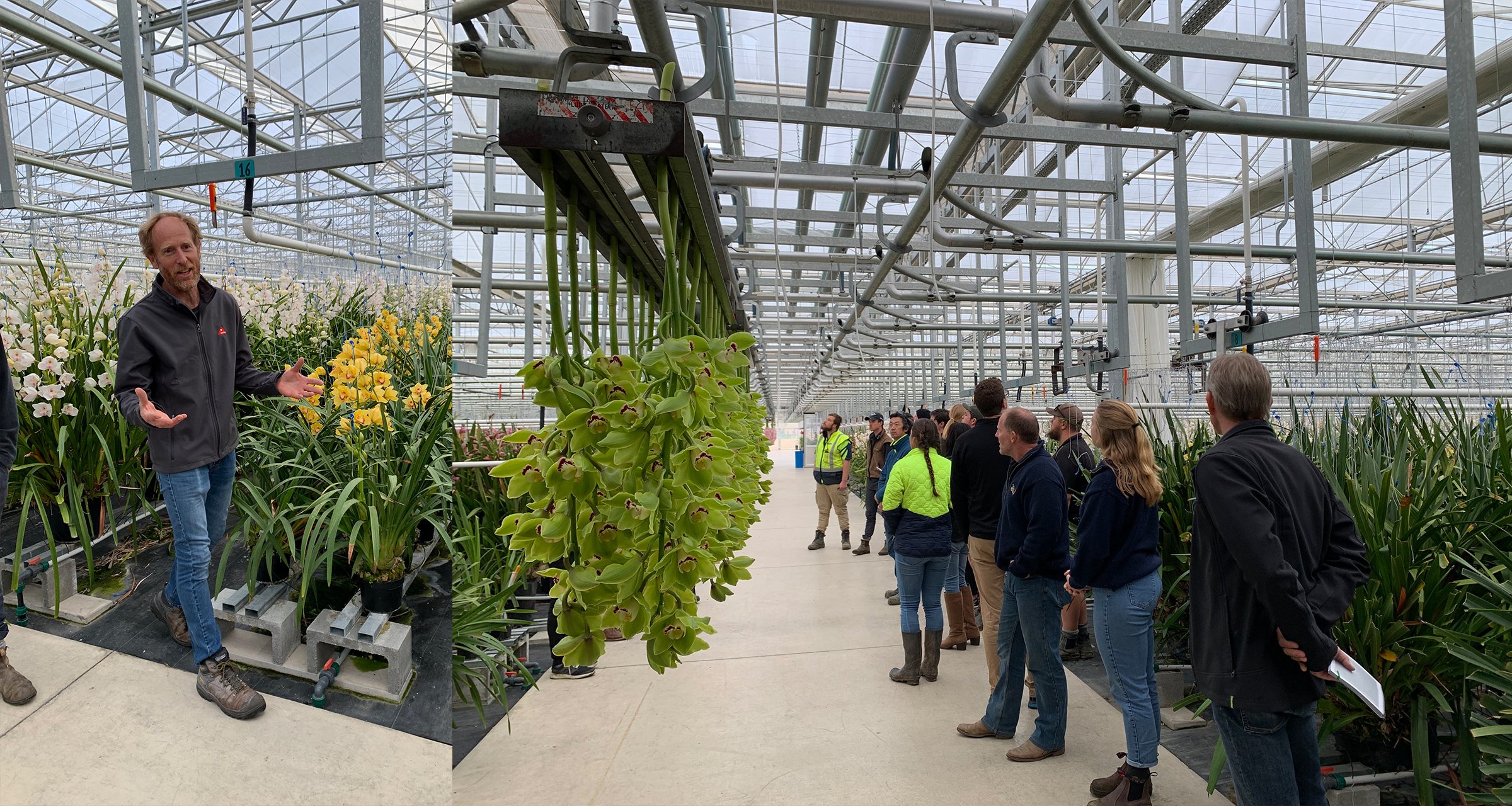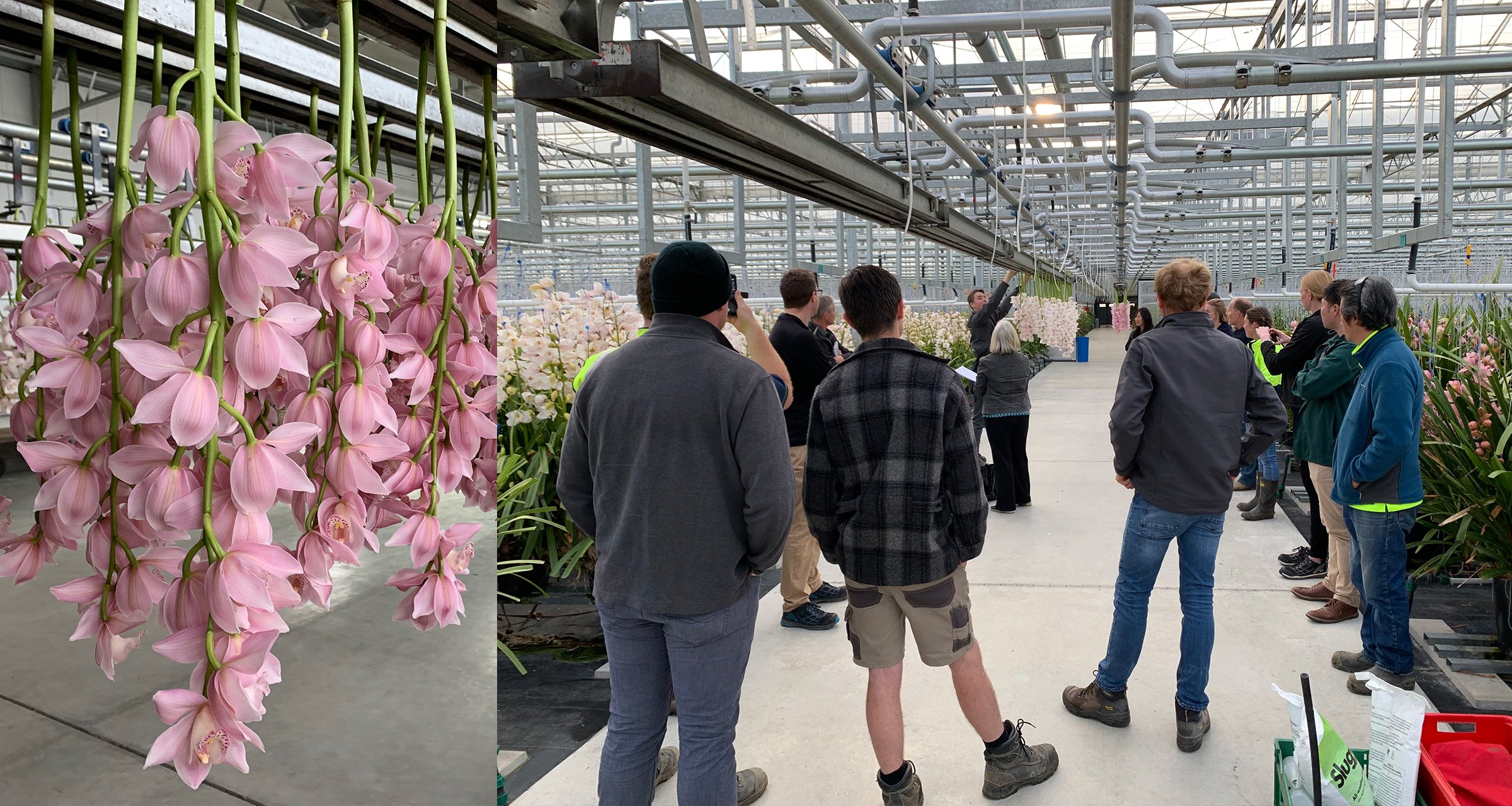SPS YOUNG GROWER FIELD TRIP TO JOSHUA CYMBIDIUMS
01 Sep 2020

The Pukekohe Young Growers Group found Orchid growing to have many similarities to covered crop varieties following a recent visit to Joshua Cymbidiums.
The group has a membership of around 60 with 20 to 25 regularly attending breakfast meetings mainly held in Winter and Spring as Summer-time work schedules prove too busy.
On their September outing Gus Sonneveld explained how he founded Joshua Cymbidiums with his identical twin brother, Joe, on what had been a dairy farm at Drury, south of Auckland. They’d immigrated from Holland in 1987 after following their grandfather and father into floriculture. Their operation had 5,000 young plants and 1,500 early flowering varieties in production. Knowing they needed to expand to extend the growing season they searched for the right piece of land for two years before finding a block at Buckland in 2011.
“We bought it in December then the pressure was on to build the glasshouse because we were growing lots of small plants which needed more space,” Gus says. “It was hard work but we always had a long term vision for what we were doing.” They now produce 200,000 stems a year from April through to November.
A 10,000 square metre building was erected at Buckland, of which they use only half for growing so there’s plenty of room to expand. All of the 60m by 12m floor is heated which at present includes the grading and packing areas. Water supply from a reservoir was initially adequate but 18 months ago they put in a bore, a good decision as it turned out with last one being a dry year for the wider Pukekohe area.
Natural gas heating keeps the temperature of water pumped through pipes consistently high but they soon found it was not so easy to control humidity. The answer was a second set of pipes installed at a lower level. Automated screens control the amount of light reaching the plants extending their production season as well as reducing energy use. Sprinklers are also activated in the summer when the crop can get dusty.
While they could have diversified into other covered crops they made the decision to stick with what they knew, despite the fact that costs can’t be trimmed a great deal. Labour is their biggest cost with few areas of the growing, harvesting and packing process able to be mechanised. There are two permanent workers employed, six to eight seasonal staff and then they will find backpackers who are able to boost their workforce between the two sites at busy times. Finding two French backpackers to work for them for five weeks this spring was a real blessing, as they picked up what was required very quickly, he said. While pickers can go home when their work is finished those packing stems need to stay until all of that day’s production has been dealt with.
Plants can last for 15 years and are maintained by bulk pruning the sides and taking out the old bulbs. Up to 40 % of their workers’ time is taken up with tying up the stems. They need to be at least five foot seven tall in order to reach the wires crisscrossing the shed. “You’re spending $20 a pot before you get your first flowers,” Gus said.
While plants can be split to make a large number of smaller bulbs they prefer to use tissue culture from shoots which means that in just 18 months there can be 500 to 1,000 new plants at the ready. “We’re careful how we spend our money,” Gus adds. “It’s nice when you can put money back into the business which we’ve done instead of buying a bach or a boat.”
Two-spotted mite is the biggest pest problem, which he said they’re on top of now with a combination of predator insects and sprays. Bird damage is an issue with sparrows only deterred for one year by a laser they imported from Holland. “The flowers produce honey and they will come in and sit on them doing damage with their claws,” he said. “It’s very frustrating.”
His wife, Helma, said trends are all-important with customers increasingly wanting a stem they can look at for a long time. The Japanese like them to last at least two weeks and are prepared to pay $20 to $25 each.
“We can’t change the varieties because one colour is more popular, but if our customers are changing we have to change,” she said.
It can take four to five years to find different varieties and grow them to flowering. More new varieties are coming out of California now but for a long time five new varieties were being grown every year.
While they started producing orchids under the name Dugron, a contraction of Dutch growers New Zealand, the decision was made to switch to Joshua because of its biblical reference and the song by the group U2. The happy fact that it’s easy to say in Japanese didn’t enter their thinking. “It starts with quality production then a name comes after that,” Gus said. Their logo is a simplified triangle and work is still continuing on refining their packaging.
The final, and equally important factor, is the service provided to customers. While they worked with an exporter based at Mangere for some years they realised fifteen years ago they needed their own importer in Japan. “We’ve visited him many times and we also have a guy from Japan who worked as an auctioneer in Japan now working here,” he said. “Our brand is really well recognised.”
Two grades of cymbidiums are produced with the top grade, AAA being exported and the AA grade sold on the local market, which makes up only 10% of total production. In bad years when prices can drop from the usual $60 a box down to $40 some of the AA cymbidiums can be sold locally.
Internationally the Dutch are their strongest competitors. “They’ve extended their season from nine to 12 months,” Gus said. That means the window to sell their later flowering orchids, produced at Buckland, is smaller than it previously was. “It’s important for us to know where we’re going to be squeezed out of the market. You need some foresight into where things are going.” Before 2011 around 70% of their production was exported to Japan. “It was quite key for us to stay in the business sustainably,” Gus said.
So they decided to grow markets where the remaining 30% of production went, resulting in the Japanese market now taking around 45% and still shrinking.
“We are dealing with three main customers there but one is key because they are a cut above the rest and we’re aiming for a niche market.”
Around 16,000 stems packed into 2,000 boxes will leave their packhouse in a busy week. They run up to four packing lines with three pickers selecting stems, attaching them to an innovative trolley system which uses the heating pipes overhead to push them out of the growing area to be checked by six to eight people grading each of them by checking quality and different sizes. Six large stems will fit a box, eight to 10 medium sized ones or 12 small stems. Some boxes contain cymbidiums all of the same colour while others, often on their way to Japan, have a mix of different colours. Yellow seems to be the preferred colour this year.
Gus has a simple philosophy when it comes to quality: “You don’t grade it, you have to grow it.”
A stem graded on a Thursday will be on the market from the following Monday to Wednesday. The stems need to be kept at a constant 8-12°C. “Refrigeration is a big no no,” Gus said. “If the temperature drops to 2°C that’s suicide - the flowers’ lips turn red.”
A big order will be for just 25 boxes, often placed by a Hong Kong customer who will take around 10% of their crop. That market is still growing along with the Middle East and the United States. Chinese imports Gus describes as “very static”.
Seven good years of prices were followed by three where prices were down as well as production, creating a double whammy effect.
“But we’re still enjoying what we do with the whole family involved,” Gus said.
Of their five children they hope that one son, who has been attending Lincoln University, may return to home in the future.
While the last two years have seen an upturn in the business Gus believes the next five years will be even better with a strong export economy and the New Zealand dollar at lower levels.
“The most satisfaction comes from turning out a quality product,” he said.
“That’s how you get through the hard years.”

By Glenys Christian